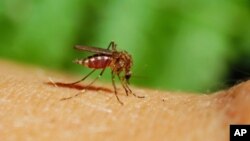Deforestation is one of the big culprits in climate change. And now a new study from the Amazon links deforestation with an increase in malaria.
Despite eradication efforts, malaria remains a significant health problem in Brazil. There are around a half-million cases a year, mostly in the Amazon basin, a region heavily affected by deforestation.
Sarah Olson and her colleagues at the University of Wisconsin used satellite data to assess loss of forests and combined that with government surveys of malaria cases.
"We show that a five percent increase in deforestation was associated with a 50 percent increase of malaria risk in these health districts," said Olson.
She says the apparent explanation is that the mosquitoes that transmit malaria like the landscape that's left after the forests have been cleared.
"The habitat preference for this mosquito appears to be these partially-sunlit pools of water for the larvae. And that's the type of thing that we get when we start deforesting an area, and deforestation creates the ideal habitat," says Olson.
This is not the first study to show a link between deforestation and malaria, but Olson says her study is notable because of the rigorous way Brazilian health officials gathered the malaria data.
"This is super-high quality, and all of the cases are slide-confirmed. That means they take a drop of blood and they look at it under a microscope, and they can confirm that this was an actual case of malaria. Whereas a lot of studies are limited to basically asking, 'Did you have a fever in the last month or six months?'"
Sarah Olson's study appears in the July issue of the journal Emerging Infectious Diseases, which is published by the U.S. Centers for Disease Control and Prevention.












